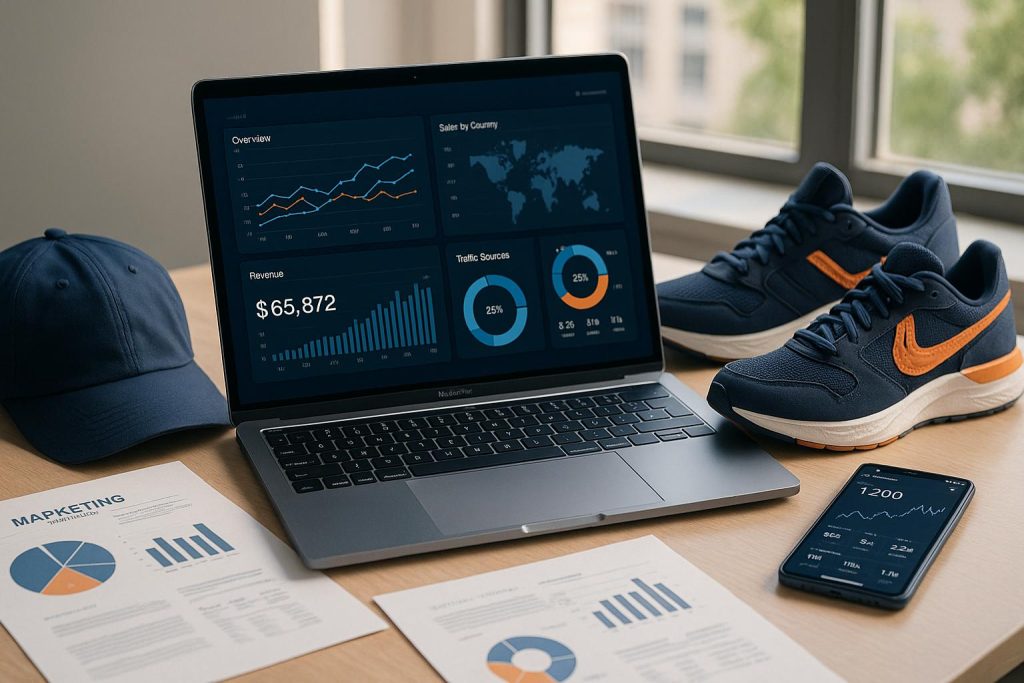How Marketing Needs New Tools: To work well, tools must manage more customer info and change as companies grow bigger. Old ways can’t keep up, but AI-powered tools can solve big problems. Here’s the plan:
- Why Bigger Is Better: Tools need to handle more data and meet changing needs as companies grow.
- Perks of AI: It does tasks on its own, guesses what customers will do, and makes targeting better for good campaigns.
- Start Simple: Have clear aims, pick the best cloud place, and follow privacy laws.
- Clean Data Matters: Tidy, sorted data means right AI ideas and strong marketing plans.
- AI at Work: Do the same tasks fast, use machine learning to guess, and make customer chats personal.
- Stay Ahead: Pick cloud services that can grow as your company needs more.
Main Point: Smart AI tools change marketing by doing tasks on their own, seeing what’s next, and making stuff just for customers – helping companies win in a world led by data.
How AI Is Revolutionizing Marketing: From Big Data to Billion-Dollar Insights
Step 1: Getting Ready
Setting up your AI’s base is key. A good start helps your system grow and fit your work needs. If you skip or rush this part, you might face many hard days later. Let’s look at it step by step.
Making Marketing Goals and KPIs
Before you jump into tech, set clear goals. Just wanting "better marketing" isn’t enough. You need clear, trackable goals for your AI to aim for.
First, find the main problem your work faces. Are more customers leaving than coming? Is it costing more to get new customers while you sell less? Or is it hard to make customer experiences feel right? Each problem need a different AI skill.
When you know the issue, set clear, money-focused goals. For example:
- If losing customers is the issue, aim to "cut the monthly customer loss from 8% to 5% in six months."
- If the problem is with lead quality, try: "Raise good leads by 40% without spending more on ads."
These goals should be rooted in key performance indicators (KPIs). KPIs tell your AI what success should look like. Points like how long customers stay, sale rates, email opening rates, how well social media works, and the cost per lead are good to watch. But avoid shallow points like site visits – they might look good but don’t always mean business is growing.
Write it all down. Your AI needs to know exactly what each KPI means, how it’s figured out, and what doing well looks like. This record is key when you train your AI models and set up automatic tasks.
Picking Cloud Platforms
Picking the right cloud platform is a big move – it shapes how your AI grows. The top three options each have their perks, so choose one that fits your team’s know-how and marketing needs.
- Amazon Web Services (AWS): Great for a wide range of AI and learning tools. Their SageMaker makes it easy to create and train models, and tools like Personalize are perfect for making suggestions.
- Google Cloud Platform: Best for data checks, especially if you already use tools like Google Analytics or Google Ads. BigQuery is top-notch for handling big data.
- Microsoft Azure: Good if you use other Microsoft stuff. Their Cognitive Services help add AI bits like chat services or feeling checks.
Consider your data keeping needs, mainly if you’re watching actions across many channels. Marketing data grows quick, and your platform should manage that growth well without slowing or costing too much.
Also, watch the cost plans. AWS, Google Cloud, and Azure each have different pricing ways. For example, AWS has separate charges for time used and space used, while Google Cloud cuts prices for long tasks. Make cost guesses based on how much data you expect to avoid cash shocks later.
First, focus on safety tools. Encryption (when data is stored and sent), access control based on roles, and record keeping are vital when handling private customer info. A good cloud space should support big AI tasks while keeping your data safe.
Meeting Data Privacy Rules
Data privacy isn’t just to dodge fines – it’s to build trust with your users. If your AI tool messes up with user info, it could hurt your name and profits.
Start by meeting rules like GDPR and CCPA. Set up automatic ways to manage permissions and handle requests to delete data. Your AI should do these tasks on its own.
Plan your system with privacy first. For example:
- Make databases that easily find and remove each customer’s record.
- Put in systems for handling permissions.
- Keep logs to see how data is used.
Data minimization is also key. Only gather the data you really need for your marketing aims. More data may look good, but it adds to your rule-following work and storage costs.
Set up keeping policies to delete data when not needed. This lowers risk and keeps your databases running well. Different data types might need different keeping times, so plan well.
Being open is important. Write clear privacy rules that tell – in simple words – what data you gather, how you use it, and how users can manage their info. Your AI should be made to follow these promises.
Lastly, think about naming a data protection leader or giving privacy tasks to certain team members. Someone must keep track of rule changes and make sure your system stays within the rules as it grows. A strong privacy plan is key for keeping customer trust and growing your AI-driven marketing work.
Step 2: Managing Data Quality and Organization
The win of AI marketing relies a lot on clean, well-set data. Right data could be the key to a strong AI job or one that does not meet goals.
Cleaning and Organizing Your Data
How good your data is links to how right your AI’s ideas are and how well your efforts work. If your data is all over the place, your AI might go wrong, using up good stuff.
Start by cutting out double stuff and using fuzzy matching to mix like things. For example, a buyer may come up as "john.smith@gmail.com" in your email list and "j.smith@gmail.com" in your CRM – your AI may see them as two folks, giving you split views. Fuzzy matching looks at name, address, and contact likes to spot matches. While many CRM tools can do this, hard cases might need special codes.
Making data looks match is also key. Make sure all dates, phone numbers, and tags look the same. If one place tags buyers as "Premium" and another says "VIP", your AI can’t link them well.
You must have rules to find errors fast. Put in checks that wave at not full things, wrong numbers (like a weird age), or data that does not match. For example, if a ZIP code doesn’t match their state, your system should warn you.
High spots can toss off your AI’s tips too. Whether it’s one buyer paying $50,000 or an odd data point, choose if to cut out, limit, or sort these odd bits to stop too-high ideas.
Keeping Data Right and Sure
Even the best-set data can get worse over time. Buyer info shifts, new data spots pop up, and systems change. To keep it sure, watch and update stuff all the time.
Set up day-to-day checks on data to watch key signs like how full records are, how well data fits across spots, and how new data is.
Real-time checks are strong too. For example, when a visitor fills a form on your site, check their email right away, make sure their ZIP code fits their city, and mark odd things. This keeps bad data out from the start.
It’s big to follow where your data came from and how it got handled. If your email opens drop fast, you can find if a new data add brought in bad emails or if an update changed how emails are stored.
Doing data checks often is gold to see trends and big issues. Plan checks every month to find and look into big shifts. For example, if your cost per customer jumps, bad data might make your AI aim at the wrong group.
First, set up ways to link your marketing outcomes and data quality. If a plan does not work well, check if old or not full data had an impact. For instance, wrong info about people might cause bad target picking, or no recent buy data might lead to off suggestions.
Use of Open and Own Data
Mixing your own data with outside data can help your AI know more about your buyers and market.
Open data, like what comes from the U.S. Census Bureau, can add to what you know about your buyers. This info can show things like how much people earn, their schooling, and how they live that you might not see from your own data.
Things like job rates or home costs can help your AI change its plans based on how the market is doing. For example, if jobs are being lost in an area, your AI might focus on messages about value instead of pushing top-end items.
Social media APIs, such as those from Twitter or LinkedIn, let you see what your users are into and doing apart from when they deal with you. For instance, Twitter can show what topics are hot in your field, while LinkedIn might show job shifts that might change what people buy.
Weather and times of the year are key in many work areas. Shops might change what they ask for based on the weather, while travel firms might change messages to match times of the year and local settings.
When you bring data sources together, make sure you use common IDs for users over systems. A main user ID can link info from many places, and guesswork matching can help when exact ties aren’t there.
Data feeding services can add missing bits to your user files, like job types or money facts. But, always check the truth of this added data before you use it for big choices.
Keep in mind that data quality can change from one source to another. For example, open data might get refreshed each year, while your own data changes daily. Your AI needs to think about these time changes when it guesses.
Putting different data together makes following rules on privacy harder. Make sure you have the right okay for all data uses, and that your privacy ways clearly tell how outside data is worked into better user files. Some data also comes with rules on how it can be mixed with other info.
Lastly, watch how each data source changes how your AI does. While some outside data can really make things more right, others might make things too complex with little gain. Often check if a data source is worth the work and cost to mix it in.
With clean, checked, and added data, you’re set to start AI-led directing in the next step.
sbb-itb-d6d4d8b
Step 3: Adding AI Tools and Automation
When your data is clean and set, it’s time to use AI tools. This step turns slow manual tasks into quick, automated jobs that work well.
Automating Marketing Tasks with AI
AI takes out the hard work of doing the same marketing tasks again and again. It deals with things like picking the best times to send emails, making good subject lines, and making content for certain groups of people. This kind of making it just for them often leads to more people opening the emails than with the same way for everyone.
With AI, sorting customers becomes much sharper. Instead of just using simple details, AI looks deeper, checking how people act to find groups that might like certain items or services more. These ideas help you make ads that really speak to your people.
AI helps a lot with handling social media too. It sets the best times to post, answers common questions, and can even offer content ideas based on what’s popular or what people are into now. One good plan is to start automating the part that takes up most of your team’s time, then do more as you see good results.
Using Machine Learning for Predictions
AI doesn’t just do tasks – it helps you plan ahead. Machine learning can guess trends and what customers will do, like what they might buy next, their total spend, or if they might stop buying. This lets you change your ads on the go by tweaking who you target, how much you spend, and what your ads say based on how well things are going.
For example, AI can notice things like less people being interested or unusual buying, showing you customers who might stop buying. You can then reach out with special offers or messages to get them interested again. On a bigger scale, guessing demand with AI helps you get ready for seasonal changes, economy shifts, or past sales trends, making it simpler to handle stock and plan marketing money wisely.
By mixing different guessing models, you build a system that not only looks for chances but also adjusts fast to changes in the market.
Adding AI Chatbots and Personalization Features
AI is great for talking to customers too. Chatbots run by AI can check leads, suggest items, and even handle simple sales – all while talking to many people at once, all day, every day.
When starting with a chatbot, it’s smart to go slow. Rather than asking too many things right away, let the talk grow naturally. For example, if someone asks about prices, the chatbot can slowly learn more about their business size or needs for a better answer.
AI-driven suggestions for products push customer interest even higher. By looking at what they looked at or bought before, these systems offer items that fit what each customer likes. Many online stores have done really well by adding these suggestion systems into how they treat customers.
Changing up content is a big shift. Sites and emails can switch up based on who you are. If you’ve been there before, you might see a main page with stuff you’ve looked at. New folks might get a welcome to the brand. AI can also fix prices and deals to fit what you like, not just the same old stuff.
To make personal changes work, they must feel right and keep your info safe. Add new parts one by one, check how they do, and keep it all running smooth for both your tech and your customers.
For tips on using AI in your ads, go to JeffLizik.com.
Step 4: Making it Bigger and Better
When your AI tools are up and running, the next step is to make sure they can deal with more data and user action without any issues. At the same time, your system has to stay up-to-date with the changing needs of your business. To do this, using flexible cloud options is a main way to keep things running well and to help your business grow.
Using Cloud Options for Growth
Cloud services are key in making AI marketing tools that can expand with your company. They make it easy to manage resources and smooth out AI work across different systems. One top feature is active scaling. This means the system ups its power when needed and cuts back when it’s not as busy. This makes sure your system works well, no matter how much work it has.
End Thoughts: Making Marketing Plans That Last
Making big AI data setups is all about making a base that changes with your business and stays up with new market needs. From start plans to good data use and automatic work, each step helps make sure your setup can grow and change. Firms that do well in this area use a clear plan for AI, looking at data quality, setup growth, and steady bettering from the start.
Top Pros of Big AI Marketing Setups
A strong AI marketing setup does more than just run jobs on its own – it gives true, clear gains:
- Better Work: Hard jobs like data checks, group sorting, and plan bettering are done on their own, giving more time for big thought plans.
- Sharper Customer Aim: Quick data work lets you give one-of-a-kind experiences at a big scale.
- More ROI: Clever ad spends, less waste, and a strong focus on money-making customer groups bring better returns.
- A Win in the Market: With setups that keep learning and getting better, firms can guess what a customer will do and find new chances, making a growth and polishing round.
These pros show why big AI setups are key in today’s marketing. Now, it’s time to take more steps to mix and keep them going well.
Steps to Go Ahead
Here’s how to start using these ideas:
- Check your data: Look at what you get, how you keep it, and if it’s set for AI use. Many firms find they need to sort and clean their data first.
- Start small but strong: Pick one key use case – like email making personal or group sorting – and get it right before bringing AI into other places.
- Push joint learning: Make sure your marketing group knows AI tools, and your tech group gets what marketing aims at. This mixed know-how is key for long-term wins.
- Plan for more: Make your setup with growth in mind. Making a well-thought-out setup bigger is much easier than fixing one that wasn’t made for the future.
- Keep making it better: AI setups need steady checks, tests, and updates. See AI as an ongoing path, not a one-time job.
The future of marketing is for firms that can mix AI’s strength with the human ideas and insight that lead to great plans. By following these steps, you’re getting your firm ready to do well in this AI-driven world.
For more tips on using AI in your marketing plans, visit JeffLizik.com.
FAQs
What should you think about when you pick a cloud for big AI marketing systems?
When you need to choose a cloud for big AI marketing systems, there are some key things to remember. First, check if the cloud can grow and stay reliable as your needs get bigger and not let you down in how well it works. Look for modern AI tools like TensorFlow or Vertex AI that can help you build and start using your system.
Being able to change is also very important. Clouds that let you use different setups, hybrid styles, or multiple clouds let you change as your business changes. This ability to change can really help when you think about how your business will grow later.
You must have good security and follow rules. Make sure the cloud has strong privacy, safety steps, and rule-following bits to keep what you do in line with laws. Also, low delay times and fast work are needed to give real-time info and make smooth experiences for users.
The best cloud for you will match how well it meets your marketing needs and tech needs. Picking a cloud with thought can help build strong support for your future wins.









